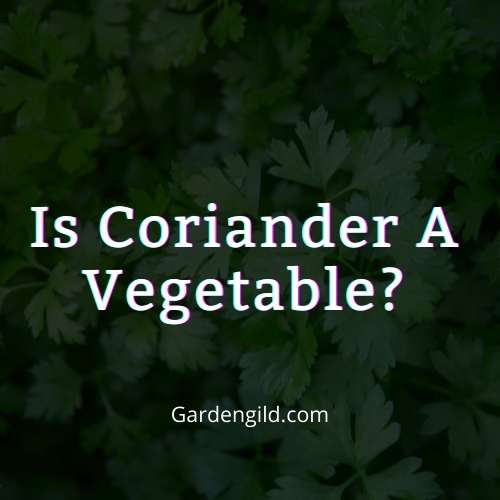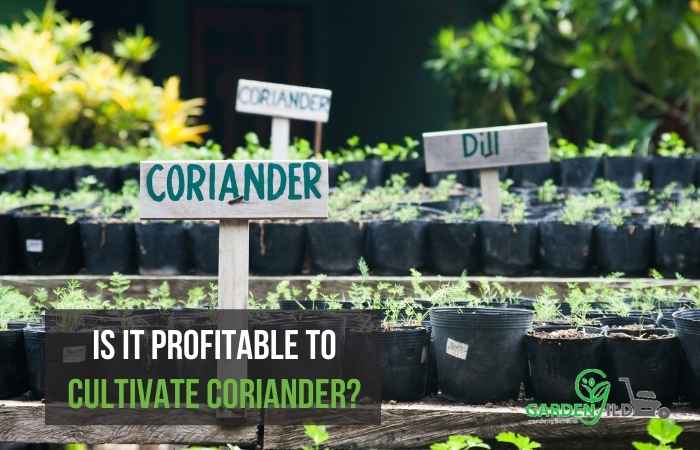All things considered, howdy! A couple of days prior, while chopping up some coriander leaves for my chicken tikka, I coincidentally found a question. Is coriander a kind of vegetable as a whole? Do you have a similar inquiry also?
Then, at that point, you have come to the perfect place. But, furthermore, I should let you know that your logical psyche marvels at me.
Subsequent to posing the consuming inquiry, I went on the web and went full Sherlock Holmes mode (ha-ha joking). I considered and explored the point well indeed, and I am here to address the entirety of your question.
In this way, stay close by and continue to read this article. You will be staggered by the real factors.
In this garden gild guide we’ll discuss the following:
- Is coriander parsley?
- Is coriander same as celery?
- How to cultivate coriander?
- Is it profitable to cultivate coriander?
- What are the overall conditions of growing coriander?
- FAQs

Is coriander a vegetable or herb?
Coriandrum sativum, globally known as coriander, is a lime green small plant with pinnate leaves. It grows around the whole world, and it is part of the parsley family.
Extensively, you can find the use of it around the globe in almost every cuisine as it enriches the flavor of foods, salsas, sauces, and soups.
No, it is a herb. Herbs are plants with seeds, leaves, and flowers widely used for medicine, perfume, flavoring, and food. The coriander plant also bears seeds, and the leaves taste completely different to the ripened seeds.
The leaves have a very lemon-like and pungent type of flavour. Almost acidic. On the other hand, the seeds taste very aromatic with a nice aroma, especially when dried up.
Even though seeds have a distinct flavor of their own, they do not override the whole flavor of the dish. In this way, the seeds are similar to the leaves. So, there you go, coriander is a herb.
Is coriander parsley?
No, coriander is not parsley, they are not the same. To understand the difference, let’s know what they are at first. Coriander is a leafy plant that is used as a staple ingredient to help garnish in different cuisines all around the world. They have a very pungent taste.
Parsley is also a leafy plant, but it belongs to the Apiaceae and is scientifically known as Petroselinum crispum. They are green in color as coriander, and that is why they both are mistaken as the same widely.
Now let’s see the key differences between them. First, parsley originated from the Mediterranean region and coriander is believed to have originated from western Asia and southern Europe.
The parsley seeds are oval, and they can provide enough oil for medicinal purposes. On the contrary, the coriander seeds are round, and they have no oil rather, they are used as a spice. Also, the parsley seeds cannot be consumed directly. So the edible parts of parsley are the roots and leaves. But every part of coriander is edible.
You can also distinguish between parsley and coriander by their flavor. The taste of coriander is more flavored and more pungent than parsley. The taste of parsley is more grass-like and mild.
Is coriander same as celery?
Even though they belong to the same family, both are different and have a huge taste difference.
Celery tastes nothing like coriander. Instead, the flavor is slightly sweet, radish-like, slightly bitter, very green-y and refreshing. The celery leaves are more herbal tasting, bitter and less palatable than the stems but still edible.
Though the leaves have nutritious value, I never eat them. They are just too much for my taste buds.
The celery seeds also have their own taste, and you will find the smell more woody and musky yet very strong.
And we all know coriander is aldehydic, citrus-like and pungent. And the coriander seeds are more spice-like and have a linalool smell. So, we can say that coriander is not the same as celery.
How to cultivate coriander?
Did you know that coriander doesn’t only enrich the flavor of your foods but also works as an anti-poisoning agent? Well, now you know. And now you want to cultivate coriander. Coriander can be cultivated indoors, too, with enough sunlight.
Let’s see the step by step process of it.
- Buy some good coriander seeds, preferably the non-GMO coriander seeds that are pure.
- Coriander grows well in a temperature range of 17degree to 28 degrees Celsius. So you don’t have to moist them and wait for sprouts. Instead, you can directly sow them in well –drained soil. But please make sure that your soil has a pH level of 6.2 to 6.8.
- Sow the seeds at least half an inch deep and space the seeds with a gap of 6 inches. Bury the seeds with more soil and add a half-inch layer of mulch.
- Water properly and especially in dry periods.
- Ensure that your soil has good water drainage and do not overwater them at any cost. Coriander tends to have deep taproots, so ensure proper water drainage.
- The germination will take up to as little time as 3 weeks. If you want to extend coriander harvest, always snip off soft stems.
Is it profitable to cultivate coriander?
Yes, it is profitable to cultivate coriander if you cultivate properly. Cultivation of coriander requires low production costs and easy maintenance. It is profitable than most crops and more profitable than paddy.

If you consider investing $200 in coriander harvesting, you can earn a profit of up to $1000 per acre, which doesn’t seem so bad. So we can say that coriander cultivation is profitable.
What are the overall conditions of growing coriander?
No matter how low-maintenance a crop requires, there are always some conditions to meet if you want to harvest properly and earn proper profit. The same goes for the growing of coriander.
Outdoors
Coriander is grown throughout the year, but it is best grown from March to August. Coriander prefers a cool environment and a light shade over them. They require well-drained soil too.
Indoors
Indoors coriander is mostly grown in pots with little holes in them to drain the soil. You also have to make sure that the plants do not get burning, direct sunlight in the summer season.
people also ask
1. Is cilantro coriander or parsley?
Cilantro is Spanish for coriander leaves, so, cilantro is coriander.
2. What are the benefits of coriander?
They enrich the flavor of foods, works as an anti-poisoning agent, rich in vitamin K & C, iron, calcium and many more.
They also help your skin health, gut health, brain health and reduce sugar levels in blood.
Read Also:
Is coriander a vegetable? Final Thoughts
Hope we can give you the details about coriander’s benefits and growing process and everything else in between. We tried answering every relevant question.
Coriander is a crucial part of our diet. There is no doubt about that. Hope you got all the answers you needed.
